Scientific Publication Trends and the Developing World
By Mercedes Maqueda, Eva Valdivia, Antonio Galvez
What can the volume and authorship of scientific articles tell us about scientific progress in various regions?
What can the volume and authorship of scientific articles tell us about scientific progress in various regions?

DOI: 10.1511/2000.41.526
It is one thing to record scientific progress but quite another to attempt to measure it. The matter is complicated by the fact that a nation's scientific capability plays a (perhaps, the) key role in its economic progress, yet economic progress just as clearly fosters advances in the sciences. The two are difficult to untangle.
Nonetheless, the available measures do link scientific progress to economic progress in an indirect but compelling way. Three of the four most economically powerful regions—North America, western Europe and Pacific Asia (Japan, Taiwan, Korea and Singapore)—spent the largest percentages of their gross domestic product on research and development—2.5 percent, 1.8 percent and 2.3 percent, respectively, in 1998.
Although science or its forebears has been bound to economics since the dawn of civilization, its influence on prosperity has burgeoned in modern times. As a result, the scientific and economic gaps between so-called developed and developing (or underdeveloped) nations have become immense and continue to grow. Developing nations have become dependent on developed nations not only economically but also scientifically—not so much for want of scientists and scientific effort as for the means to fully utilize each.

Gregory G. Dimijian/Photo Researchers, Inc
What are the global patterns of scientific progress, and how do they affect the developing world? To find answers, we chose to survey the scientific productivity—in terms of publications in international scientific journals listed in the Science Citation Index (SCI)—of 160 nations from 1991 through 1998. The SCI is widely used, but it is worth noting a few of the criteria used to include publications in the index. Besides exhibiting quality and timeliness, journals must include English language titles, abstracts and keywords, must have authors from multiple countries and must cover a field not already covered by another journal. These restrictions eliminate certain regional or national journals from consideration.
We looked for quantity of publications per nation and per capita, for changes over the study period and for patterns in authorship. Publication is not, of course, inevitably linked to scientific progress, but the measure does provide insights into both worldwide scientific productivity and the way that scientific results get published.
During the period from 1991 through 1998, 85 percent of all scientific papers originated from three regions: western Europe (the European Union, Iceland, Norway and Switzerland), North America (the U.S. and Canada) and Asia (Hong Kong, Indonesia, Malaysia, the People's Republic of China, Singapore, South Korea, Taiwan, Vietnam and, especially, Japan)—and about 70 percent were attributable to just western Europe and North America. Eastern Europe accounted for the largest share of the remaining publications, with Oceania (primarily Australia and New Zealand), Latin America (mainly Argentina, Brazil, Chile and Mexico) and the Middle East (mainly Israel) contributing roughly equal amounts. The African continent as a whole, by contrast, managed little more than 1 percent of worldwide scientific productivity (see Figure 2), with northern Africa contributing the least of any of the regions in the study—fewer papers than were produced by Greece or some Latin American countries alone.
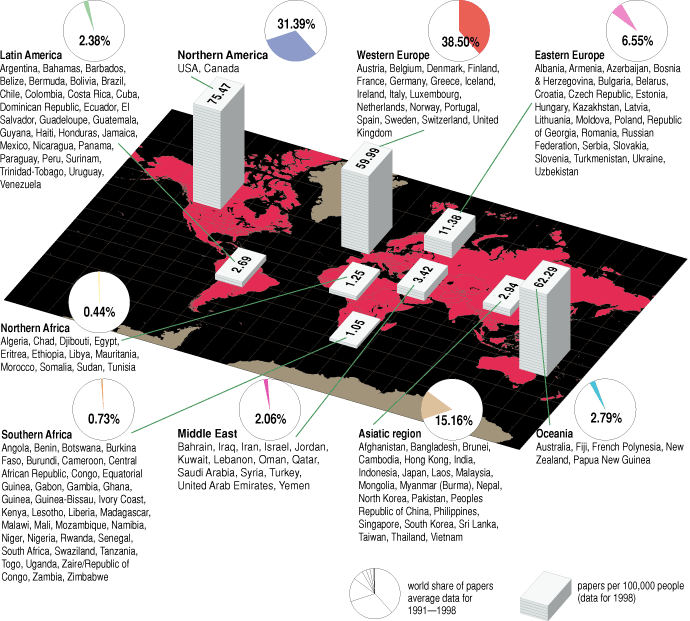
Barbara Aulicino
In addition to sheer volume of publication, scientific productivity might also be gauged by the number of scientific articles produced per capita in various nations. Such analysis leads to the conclusion that the North American population is about 72 times more productive in terms of scientific publication than is that of southern Africa, the least productive region in the study. Moreover, South Africa produced 53.12 percent of the papers from southern Africa; other than Nigeria, Kenya, Tanzania, Zimbabwe and Cameroon, no southern African nation produced more than 100 papers per year. Other developed regions (western Europe and Oceania) showed similar, although slightly smaller, disparities in productivity compared with developing regions. And such differences can be even larger for individual nations; some nations of southern Africa had no detectable scientific output.
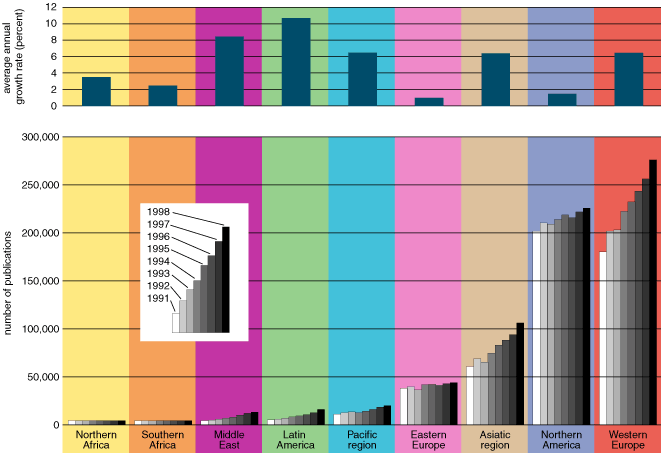
Annette Deferrari and Tom Dunne
Perhaps even more interesting than static levels of publication volume are the trends for different parts of the world over the study period. In keeping with the dominance of developed nations in total volume, we could detect substantial increases in scientific production only in developed regions, especially western Europe and Asia (see Figure 3). By contrast, developing areas such as eastern Europe and Africa showed no significant signs of progress. For example, from 1991 through 1998, the number of publications per year from western Europe increased by 96,000, a figure that exceeds the entire productivity of Africa, Latin America or the Middle East for the eight-year period.
Moreover, the world share of papers from western Europe increased from 34.1 percent in 1991 to 38.5 percent in 1998, placing the old continent ahead of North America for the first time. Most of the western European countries experienced steady publication growth during this period, largely as a result of scientific programs under the auspices of the European Union. In terms of percentage growth, both Latin America (10.42 percent) and the Middle East (8.28 percent) exceeded western Europe (6.30 percent), but its large facilities allowed western Europe to top the world for total production.
Eastern Europe offers a much different picture: The region had the lowest average growth rate of all, at less than 1 percent. These mostly former Soviet nations suffered (and in some cases continue to suffer) the consequences of political turmoil, and their scientific production has decreased noticeably. The number of publications originated by Russia dropped by an average of 6.86 percent each year, and its publication share within the region dropped from 69.77 percent in 1991 to 45.95 percent in 1998. That huge decline was offset in part by nations with moderately high growth rates, including Poland, the Czech Republic, Slovakia and Romania. Nevertheless, the world share of papers of the most productive nations in the region declined, and thus the region's overall ranking is very low. In most cases, the scientific production per capita of these nations is also very small, ranking them closer to developing than to developed nations.
Other regions with relatively strong publication growth include Asia and Oceania. In particular, Japan rose to become the number-two producer of scientific papers in the world, after the U.S. But Japan was not the only nation in the region to enjoy success during the 1990s. South Korea, Hong Kong, Taiwan, Vietnam, Singapore, Indonesia, Malaysia and the People's Republic of China all turned in strong performances. Overall, the Asiatic countries showed average growth of about 6 percent per year and increased their world share by 2 percent from 1991 to 1998. If the present trend continues, 10 years from now the Asiatic region will collectively produce as many scientific papers as does the U.S. Although they produce fewer papers overall than their more populous Asian neighbors, Oceania nations had the fourth highest growth rate among all regions.
Scientific production in the Middle East is dominated by Israel, which produced 54 percent of the region's scientific articles, followed by Turkey, Saudi Arabia and Iran. Israel also produced the greatest number of papers per capita, but the largest annual growth rates were in Lebanon, followed by Turkey and Iran. As a result of the Gulf War and the embargo since, Iraq's scientific output has dropped dramatically; 1998 saw 50 percent fewer publications than 1991.
Northern Africa's scientific output grew only modestly during the period studied, and the main contributor, Egypt, experienced no increase at all during the latter half of the decade. Nations such as Morocco, Algeria and Tunisia had much higher yearly growth rates, perhaps, as we shall see later, because of cooperation with western Europe.
Although southern Africa has more nations than any other region, it experienced not only the second-lowest production of scientific papers but also the second-slowest growth rate. The scientific productivity of most of these nations falls between negligible and nonexistent, and there are few signs of the situation improving. These results are no less alarming than the socioeconomic data coming from the region. At the current pace, scientific progress, and thus social welfare, seems far from being an achievable goal for most of the nations in southern Africa. A drastic change must take place before these nations can abandon the tail end and begin to catch up with the rest of the world.
The American continents offer a good example of the divide between developed and developing scientific productivity. To the north are the world leaders, Canada and the U.S., and to the south, Latin America looks forward to closing the gap. There are, in fact, signs that this arrangement may be changing. The world share of papers from North America has decreased markedly and is now at its lowest level in many years. For example, that share was 39.72 percent in 1985, 38.17 percent in 1991 and 31.39 percent in 1998. Although Canada increased production during the period, the U.S. output declined 4 percent from 1991 on, probably because of restrictions in government funding early in the decade. The overall growth rate of 1.56 percent bests only that of eastern Europe.
Latin America, on the other hand, has the highest growth rate of all regions, at 10.42 percent per year; from 1991 to 1998 its world share of scientific papers increased from 1.61 percent to 2.38 percent. (This actually may be an underestimate, since Latin America has a large number of scientific journals that are not listed in the SCI.) This gain can be attributed to scientific interest in the region's resources, its proximity to the U.S. and cooperation with western European scientists. This success should be tempered, however, by the fact that only a limited number of nations are participating in it. Only Argentina, Brazil, Chile and Mexico show strong signs of scientific progress, accounting for 86 percent of the region's scientific production. Furthermore, the number of publications from the rest of the nations in the region did not increase noticeably during the study period.
Science is commonly said to be a collaborative enterprise, but the means of collaboration can be especially important to developing nations. In addition to the total number of contributing authors per publication, collaborations between research groups in different countries and tendencies to collaborate with scientists from particular countries are of interest.
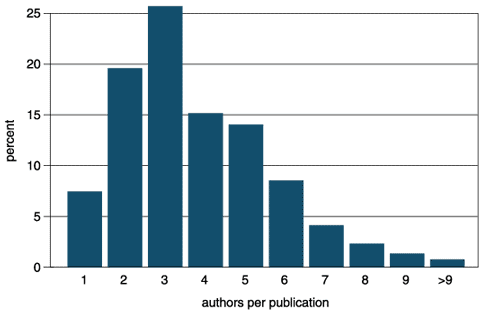
Annette Deferrari and Tom Dunne
Author counts demonstrate that collaboration is the norm; scientific publications with a single author are infrequent. The average number of authors per publication in the late '90s was 3.80, publications authored by three investigators were most frequent, and a very high percentage had no more than five coauthors (see Figure 4). Although some have argued that papers with 10 or more authors have become more common, we found these to be very rare (0.85 percent). We did, however, find one recent publication with 102 coauthors.
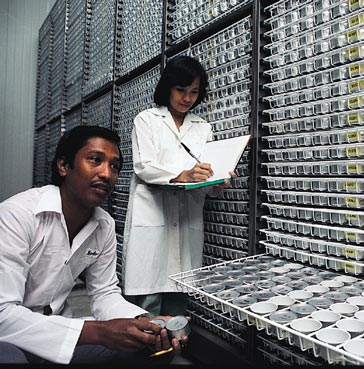
Tekeshi Takahara/Photo Researchers Inc.
The frequency with which investigators from a particular country collaborate with colleagues from other nations may reflect either the level of scientific development of a nation or its dependence on external resources to get published. Although geopolitical factors of course play a role in influencing international collaboration, developed nations are far more self-sufficient in science and technology than are developing nations. Scientific progress brings new technologies that, when sold to other nations, provide the necessary funding for research and development to continue. As a consequence, the costs of scientific research in developed nations are in part defrayed by buyers, reducing the financial need to seek foreign partners.
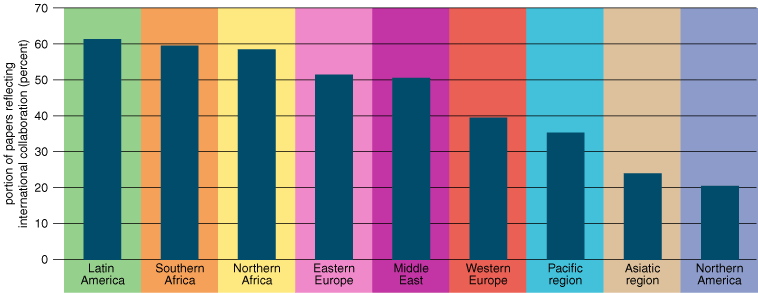
Annette Deferrari and Tom Dunne
These principles are exemplified by the two regions with the lowest indexes of collaboration: North America, at 20.63 percent, and the Asiatic region, at 24.04 percent (see Figure 5). Furthermore, it is worth noting that these numbers are heavily influenced by the U.S. (89.20 percent of publications) in North America and Japan (60.66 percent) in Asia, both scientific powerhouses in their regions. Other nations in those regions do collaborate internationally to a greater degree.
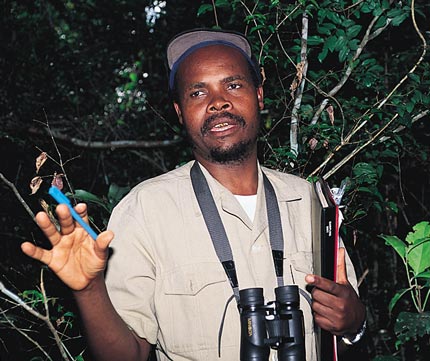
Mark Boulton/Photo Researchers Inc.
By contrast, nations that produce fewer scientific publications generally collaborate with other nations to a much greater extent, which is a clear indication of their scientific dependence. Nations from Latin America, Africa, eastern Europe and the Middle East have foreign coauthors on at least 50 percent of all scientific publications. In these regions, transnational collaboration is forced by scientific and economic need. Access to external means of publication may prove more important to a scientist's success than any other factor. And in some cases, collaboration with a foreign partner may be the only way to gain access to technologies or sophisticated equipment that may otherwise be unavailable, too expensive or beyond the technical capabilities of existing personnel to operate. The circle of scientific and economic dependence is thus closed.
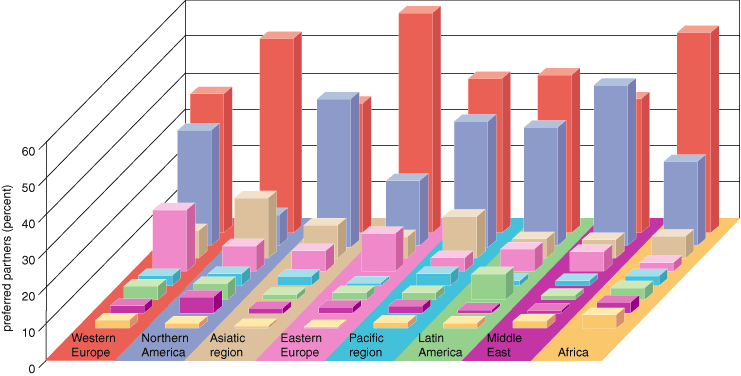
Annette Deferrari and Tom Dunne
Paradoxically, developed nations, which are disinclined themselves to collaborate, accumulate the most transnational collaborations. western Europe accounts for 44.38 percent of all international collaborations, with North America collecting 24.59 percent. The sheer volume of publications from these regions of course plays a major role in these figures, but the numbers may also reflect the desirability of collaborating with a scientifically advanced and wealthy partner. As an example, the degree of international collaboration within the nations of the African continent stands at only 5.34 percent, whereas 55.10 percent of publications from African nations involved collaboration with western Europe (see Figure 6). Conversely, western European nations collaborated freely with each other (38.15 percent), but worked with African nations on only 2.47 percent of their publications. Worldwide, the most solicited partners for scientific collaboration were the U.S., the United Kingdom, Germany, France, Japan and Italy. These data clearly indicate the extent to which the scientific and economic progress of developing nations is linked to the fate and will of developed regions.
Our analysis of indicators of scientific progress worldwide supports the idea that such progress is becoming increasingly concentrated in the developed world. As already noted, scientific and economic progress tend to feed on each other. Nations that develop strong economies naturally tend to develop strong scientific communities, and those nations that become economically strong do so because they invest in research and development. We would argue, however, that this model may not be appropriate or effective for developing nations.
If all nations were to invest the same percentage of their annual budgets in research and development, richer nations would still dedicate a much greater amount of money overall and therefore would achieve a higher degree of development. In order to move toward parity, developing nations would have to devote comparatively higher percentages of their budgets. This situation is exacerbated not only by their relative paucity of facilities and capable personnel but also by the fact that they must purchase most of their laboratory equipment and supplies from developed nations, where living standards, and therefore prices, are much higher. Thus for small economies, collaboration with developed nations may be the best approach to increasing scientific progress.
International scientific collaboration also benefits developed nations, since both the demand for productivity and the advent of advanced communication technologies are already undermining geopolitical and interdisciplinary borders. Moving actively toward this inevitability can only help developed nations be better prepared for the future. Furthermore, in spite of the globalization of science, the economic and scientific gap between developing and developed nations has grown dangerously large. In the near future, the greatest challenge facing developed nations may not be competition. Instead, it may be coping with the problem of nations and people left behind.
Click "American Scientist" to access home page
American Scientist Comments and Discussion
To discuss our articles or comment on them, please share them and tag American Scientist on social media platforms. Here are links to our profiles on Twitter, Facebook, and LinkedIn.
If we re-share your post, we will moderate comments/discussion following our comments policy.